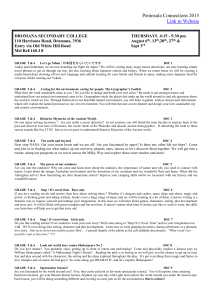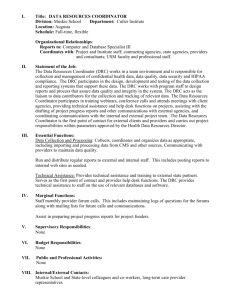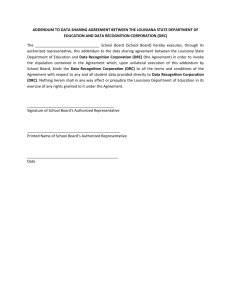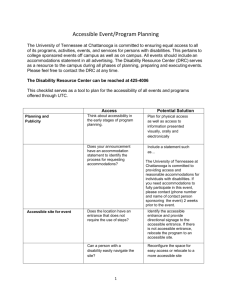NEW DEVELOPMENT OF STRATEGIC MAGAGEMENT
advertisement
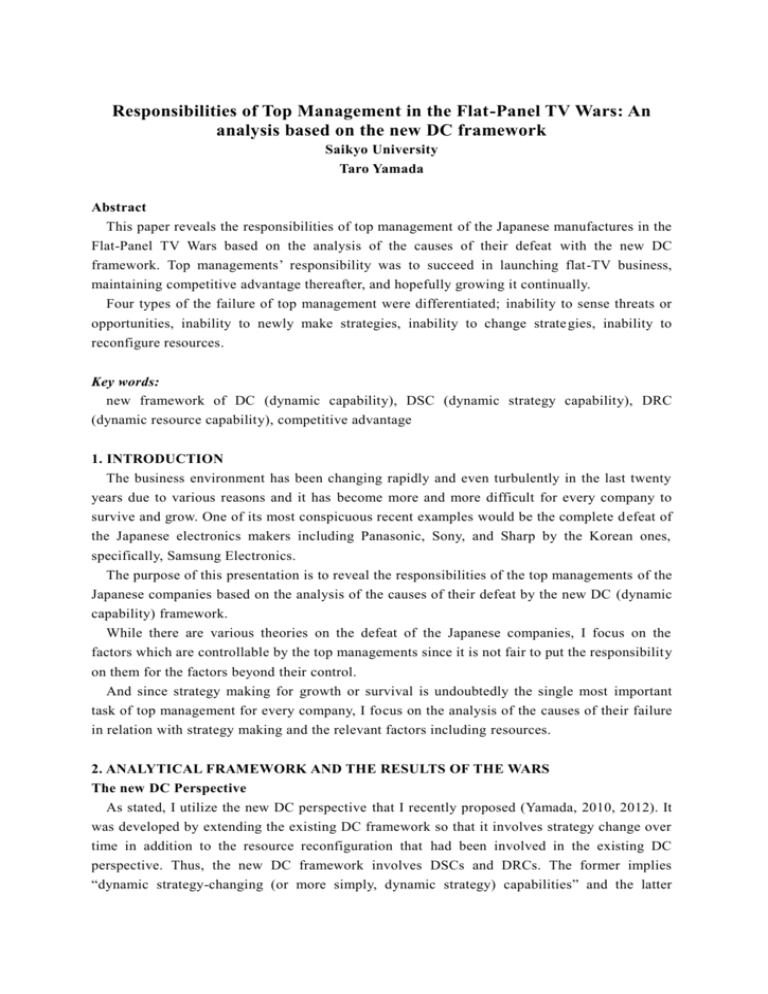
Responsibilities of Top Management in the Flat-Panel TV Wars: An analysis based on the new DC framework Saikyo University Taro Yamada Abstract This paper reveals the responsibilities of top management of the Japanese manufactures in the Flat-Panel TV Wars based on the analysis of the causes of their defeat with the new DC framework. Top managements’ responsibility was to succeed in launching flat-TV business, maintaining competitive advantage thereafter, and hopefully growing it continually. Four types of the failure of top management were differentiated; inability to sense threats or opportunities, inability to newly make strategies, inability to change strate gies, inability to reconfigure resources. Key words: new framework of DC (dynamic capability), DSC (dynamic strategy capability), DRC (dynamic resource capability), competitive advantage 1. INTRODUCTION The business environment has been changing rapidly and even turbulently in the last twenty years due to various reasons and it has become more and more difficult for every company to survive and grow. One of its most conspicuous recent examples would be the complete d efeat of the Japanese electronics makers including Panasonic, Sony, and Sharp by the Korean ones, specifically, Samsung Electronics. The purpose of this presentation is to reveal the responsibilities of the top managements of the Japanese companies based on the analysis of the causes of their defeat by the new DC (dynamic capability) framework. While there are various theories on the defeat of the Japanese companies, I focus on the factors which are controllable by the top managements since it is not fair to put the responsibility on them for the factors beyond their control. And since strategy making for growth or survival is undoubtedly the single most important task of top management for every company, I focus on the analysis of the causes of their failure in relation with strategy making and the relevant factors including resources. 2. ANALYTICAL FRAMEWORK AND THE RESULTS OF THE WARS The new DC Perspective As stated, I utilize the new DC perspective that I recently proposed (Yamada, 2010, 2012). It was developed by extending the existing DC framework so that it involves strategy change over time in addition to the resource reconfiguration that had been involved in the existing DC perspective. Thus, the new DC framework involves DSCs and DRCs. The former implies “dynamic strategy-changing (or more simply, dynamic strategy) capabilities” and the latter implies “dynamic resource-reconfiguring (or dynamic resource) capabilities.” The relationship between DSC and DRC can be explained in reference to Figure 1. It represents that when environment changes in such a way as [E1➝E2➝E3], strategies have to be changed in such a way as [S1➝S2➝S3] and, then, in response to the latter, resources have to be reconfigured similarly in such a way as [R1➝R2➝R3]. Environment E1 E2 E3 Strategy S1 S2 S3 DSC Resources DSC R1 R2 1 R3 1 DRC DRC FIGURE 1 Relationship between DC and Strategy Comparison of the Tracks of the Four Companies Table 2 represents a part of the tracks of the four companies in the flat-panel TV wars concerning the major type of TV of each company: the LCD TV for Samsung, Sharp, and Sony, TABLE 1 COMPANY SAMSUNG STRATEGY BM Resources ENVIRONMENT Phase 1(98~03) Early Growth Phase 2(04~05) Late Growth Phase 3(06~08) Transition Phase 4(09~11) Early Mature New entry innovative fast follower Corporate Strategy ¥220B (02.2-05.6) ¥100B (03.10→05.4) Competitive Strategy low-price low-price ・vertical integration ・SCM ・vertical integration ・SCM Resource ・in-sourcing ・out-selling New entry innovative fast follower Corporate Strategy ¥30B Competitive Strategy low-price +differentiation (X) low-price +differentiation (X) low-price +differentiation (X) low-price +differentiation (X) BM vertical integration vertical integration vertical integration vertical integration Resource in-sourcing in-sourcing (under) in-sourcing (over) in-sourcing (over) BM PANASONIC Tracks of Four Copmanies (?→01.5) ¥200B (05.2→06.4) ¥100B ( ? →07.9) ¥100B ・low-price ・differentiation (Y) + high-price ・vertical integration ・SCM ・low-price ・differentiation (Y) + high-price ・vertical integration ・SCM ・in sourcing ・out-selling ・in-sourcing (joint line + self line) ・out-selling ・in-sourcing (joint line + self line) ・out-selling ¥60B ¥90B ¥180B ¥210B (02.5→04.4) (04.5→05.9) (06.1→07.6) ( ? →09.6) (07.1→09.5) and the PDP TV for Panasonic. More specifically, it summarizes the measures taken by the four companies in the four phases, and they are described in the order of the method of new entry, corporate strategy, competitive strategy, BM (business model), and resources (Helfat et al., 2007). Causes of Failure of Japanese Makers The causes of failures of the Japanese makers are summarized in Table 2. (“P0➝P1” in Figure 4 implies the shift from “before Phase 1” to Phase 1 and “P1➝P2”, from Phase 1 to Phase 2, and so on. The marks, “○,” and “×” in each cell represent “success” or “failure” of the DSC or DRC respectively in the above shifts.) TABLE 2 Evaluation of DC of Four Companies Environmental Shift DC SAMSUNG PANASONIC SHARP SONY P0➝P1 P1➝P2 P2➝P3 P3➝P4 DSC ○ ○ ○ ○ DRC ○ ○ ○ ○ DSC ○ × × × DRC ○ × × × DSC ○ × × × DRC ○ × × × DSC × ○ × × DRC × × × × As evident from Table 1, Samsung succeeded in changing not only corporate and competitive strategies over time in response to the environmental changes (i.e., mobilization of DSC) but also resource configuration in response to the strategy changes (DRC). In contrast, while Panasonic made a success in the shift of [P0➝P1] by taking a strategy of “innovative first follower” in Plasma TVs (DSC, DRC), it failed in the end by stubbornly sticking to the strategy of vertical integration, investing too much in production facilities irrespective of a threat of excessive capacity, and also sticking to the competitive strategy of low price and hard-oriented (Type X) differentiation strategies (DSC, DRC). Similarly, while Sharp made a great success in the shift of [P0➝P1] by making a strategy of first mover, it also failed in the end because of passive stance for investment in production facilities and the adherence to the Type X differentiation strategy (DSC). On the other hand Sony made a big mistake in the selection of the type of flat-panel TV and while it recovered somewhat by making alliance with Samsung in the shift of [P1➝P2] (DSC ), it also failed in the end because of the repeated failure in restructuring its business model (DSC, DRC). 3. RESPONSIBILITIES OF TOP MANAGEMENTS Top managements’ responsibility was to succeed in launching flat-TV business, maintaining competitive advantage thereafter, and hopefully growing it continually. It is apparent that, while Samsung’s top management fulfilled his responsibility, those of the Japanese makers didn’t. More specifically, they were quite insufficient in fulfilling responsibilities concerning both DSC and DRC (Ambrosini & Bowman, 2009). The causes of failure of top managements of the Japanese makers in fulfilling responsibilities are summarized in Table 3. Table 3 Types of Failure FAILURE DC Type Sensing inability to sense threats or opportunities ・satisfaction with status quo ・less ability to make strategy SONY ・less resources SHARP SONY ・less ability to overcome sectionalism/rigidity SONY inability to change strategies ・lack of flexibility ・lack of concept of “dynamic strategy” PANASONIC SHARP SONY inability to reconfigure resources ・less ability to overcome sectionalism/rigidity SONY Seizing DRC Reconfiguring ・less ability to sense PANASONIC SHARP SONY inability to newly make strategies DSC Causes Relevant Company REFERENCES Ambrosini, V., & Bowman, C. 2009. What are dynamic capabilities and are they a useful construct in strategic management? International Journal of Management Reviews, 11: 29-49. Helfat, C, E., Finkelstein, S., Mitchell, W., Peteraf, M., Singh, H., Teece, D., & Winter, S. (Eds.). 2007. Dynamic Capabilities: Understanding Strategic Change in Organizations. London: Blackwell. Yamada, T. 2010. Proposing a model of dynamic strategy for developing new business development. Journal of Strategic Management Studies, 2(1). Yasuda, T. 2012. A Dynamic Theory of Competitive Strategies: An Introduction ─ To Learn by Solving Seven Enigmas of Porter Theory. Tokyo: Yuhi-kaku. (in Japanese) Yin, R. K. 1994. Case Study Research: Design and Methods (2nd ed.). Thousand Oaks: Sage Publications.

